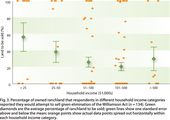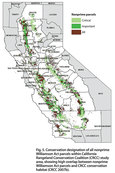Highlight
California's Williamson Act, cattle ranch economics, and biological conservation
Achievement/Results
A team of graduate students from UC Davis authored a study that described the impact of reductions in state funding for the Williamson Act, a land protection program that reduces property taxes for the owners of 15 million acres of California rangeland. The study was the lead article in the journal California Agriculture in Fall 2012. The Williamson Act enables local governments and private landowners in California to restrict specific land parcels to agricultural or open space use. Landowners receive property tax assessments lower than market value, which enables them to continue ranching or farming, and simultaneously preserves the land for biological conservation. Local governments receive a stipend from the state to help them recover lost property tax revenues. However, California budget cuts have greatly reduced funding for this program. The decision to continue Williamson Act contracts to landowners now rests with individual counties.
UC Davis graduate students Sarah Myhre, Dale Manning, Dan Swezey, Will Wetzel, and Iara Lacher used geospatial analysis and a survey of 700 ranchers to assess the potential impact of loss of Williamson Act funds on ranchers and ranch economies, preservation of open space, and implications of the loss of agricultural land on conservation. Geospatial analysis revealed that 72 percent of rangeland parcels enrolled in the Williamson Act contain habitat important for state conservation goals. When presented with a scenario of eliminating the Williamson Act, the students found that of the 365 ranchers who returned surveys reported an intention to sell 20 percent of their total 496,889 acres. The tendency of survey participants to respond that they would sell land was highest among full-time ranchers with low household incomes and without off-ranch employment. According to lead author and UC Davis doctoral candidate Will Wetzel, “In all, 37 percent of ranchers predicted they would sell some or all of their rangeland without support from the act. Of those who would sell, 76 percent predicted buyers would develop the land for nonagricultural uses — suggesting that a significant amount of California’s open space could be lost.”
Specifically, the loss of Williamson Act funding at the state level would put critical habitat across California at risk for development. Without the support of the Williamson Act, 42% of surveyed ranchers said they would sell some or all of their rangeland. In addition, 56% of ranchers predict their sold land will be developed for nonagricultural uses. “Thousands of farmers and ranchers in 53 of California’s 58 counties have participated in Williamson contracts,” said Iara Lacher, co-author and UC Davis doctoral candidate. “California rangelands not only provide forage for cattle, they encompass unique ecosystems that provide habitat for threatened and endangered species. They also form most of the major drainage basins of the state, constantly filtering and purifying the water supply.” Agricultural and Resource Economics doctoral candidate and co-author Dale Manning elaborated, "California ranching is a vulnerable, low-profit industry. Of those surveyed, 38 percent lost money, 19 percent roughly broke even, and 42 percent made a profit. Of the ranches that made a profit in 2009, 70 percent made less than $10,000.” This suggests that Williamson Act supplements are essential to the economics of many ranch communities.
Address Goals
The research describes potential effects of changes in state funding of a popular program on one of California’s major agricultural sectors. Ranching interest groups and local media outlets and blogs have widely disseminated our students’ research. In January 2013, study coauthors UC Davis doctoral candidates Dale Manning and Daniel Swezey were invited by the Santa Barbara County Board of Supervisors to present their research results at a meeting of the Santa Barbara County Agricultural Advisory Committee. Further, in addition to statewide analyses, the students incorporated supplementary analyses specific to Santa Barbara County. Meeting participants included county supervisors, land owners, representatives from trade organizations, and University of California cooperative extension specialists, who distributed reprints of the students’ paper and commented on the importance of the article for the ranching industry in California.
According to University of California Cooperative Extension Specialist Richard Enfield, Santa Barbara County Agricultural Commissioner Cathy Fisher was pleased with the quality of the information presented. Enfield felt that the student’s presentation helped reinforce the value of the Williamson Act in Santa Barbara County in particular. He elaborated, “It was another way to show the county the importance of [the University of California] and how the work we do at the University level impacts and helps inform work and policy decisions at the local level.” Paul Van Leer, a rancher and 2013 chair of the Santa Barbara Agricultural Advisory Committee, subsequently wrote to the students to express his appreciation for their presentation. Van Leer commented, “I learned a great deal and found your comments helpful. There is a definite need for policymakers and the general public to become better informed on this topic…Thank you again for such an informative presentation.”







